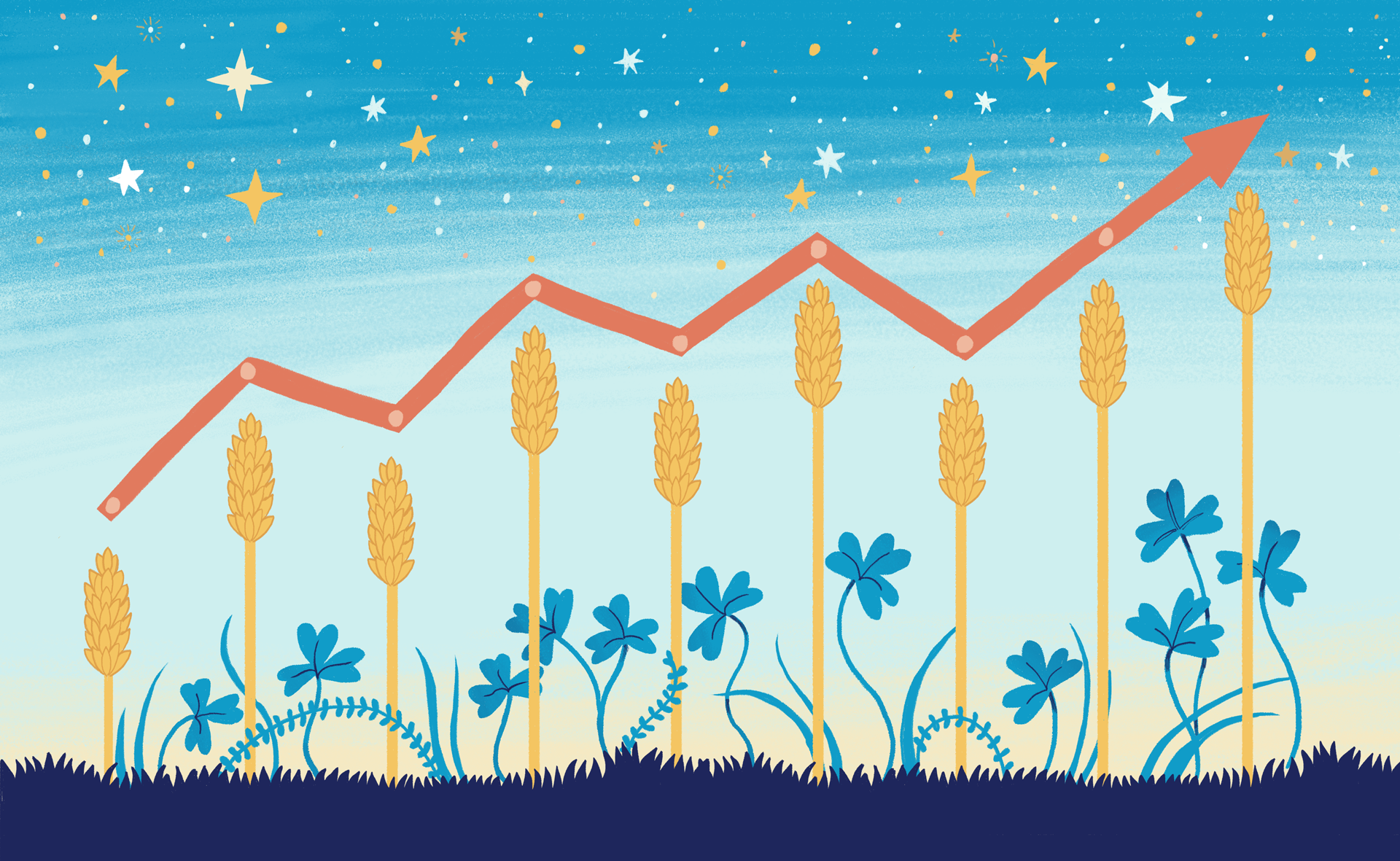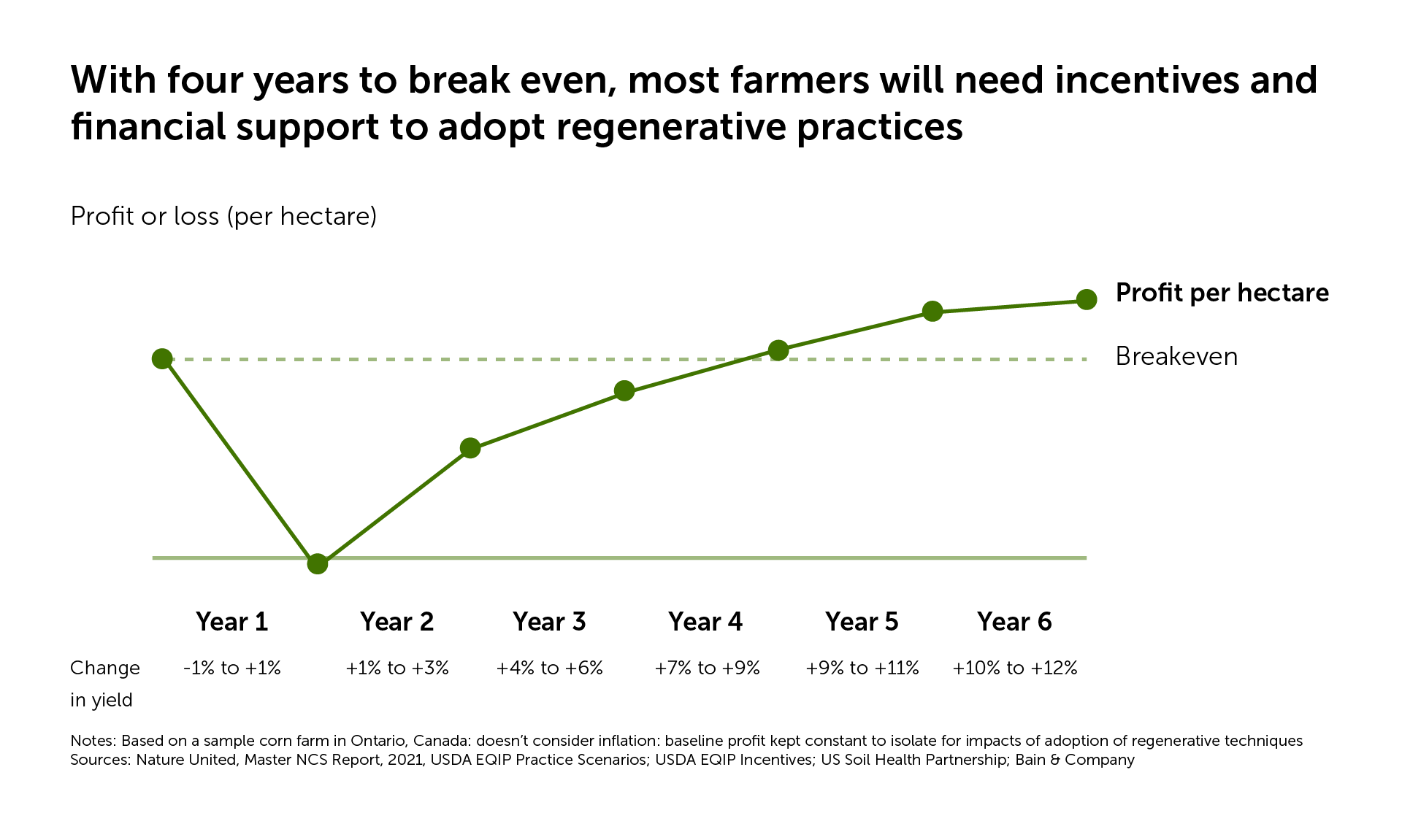You must log in or register to do the quizzes, complete the course and receive a certificate.
3.3. More profitable agriculture
Crop security is the most significant and undisputed financial incentive when it comes to the profitability of agriculture and the continuity of high-quality food production. In the long run, the transition to regenerative farming will benefit farmers economically in other ways as well. Research and visions for the future include the following financial opportunities for regenerative farming.

Better harvests
Although the impact that regenerative farming has on crop yields has been studied, the results are not indisputable. However, some researchers still promise not only crop security, but also higher yields. According to the most optimistic studies, the transition to regenerative farming can increase crop yields by up to a third. Yet this won’t happen overnight – it will take several years.
Below you will find an interesting example of how one farm transitioned to regenerative farming. This example illustrates how the transition to regenerative farming could look in terms of crop yields, and how support for farmers is particularly important during the early stages. However, the graph does not show the situation for every farm transitioning to regenerative farming, and the impact on crop yields may also vary.

Minimal purchases
Another long-term financial benefit of regenerative farming relates to purchases. Healthy soil requires lessmineral fertilisers. Healthy soil also grows healthy plants, which also reduces the need for plant protection agents. Farmers will save on fuel and labour by minimising mechanical tillage. Usually, these savings can only be realised after you have farmed regeneratively for some time.
Responding to demand
The demand for regeneratively farmed ingredients is increasing both internationally and in Finland. More and more food companies have become aware of the environmental impact of their business, and are taking concrete action to reduce the impact of their supply chains on the environment. In Europe, this is also being strongly steered by legislation. Regenerative farming provides a solution and helps companies to make their supply chains more sustainable.
Consumers also expect sustainably produced products, which in turn creates more opportunities for growth in the market for regeneratively farmed products. Products made wholly or partly from regeneratively farmed ingredients are already available from some companies and more products are in the pipeline.
Compensation for carbon sequestration
The ever-evolving carbon market can offer financial benefits for farmers who engage in activities that promote carbon sequestration. However, consistent mechanisms for creating a functioning market are still under construction and will require reliable methods for measuring carbon sequestration.
Let’s hear what Jari Liski, Chief Scientist at the Finnish Meteorological Institute, has to say about the progress that is being made in measuring and verifying carbon sequestration.
Measuring carbon sequestration is a difficult and expensive process, and significant variation can be observed even within a single plot. While techniques for calculating carbon sequestration in agriculture already exist and are constantly being enhanced, there is still no way for everyone to reliably measure the amount of carbon stored in the soil.
How to avoid greenwashing and create a functional carbon market?
The principle behind creating a voluntary carbon market is to enable companies and other operators to make climate claims by buying climate units. A climate unit is either a reduction in greenhouse gases or an increase in decarbonisation that equates to one ton of carbon dioxide equivalent. In practical terms, this means that a farmer will be compensated for certain aspects of regenerative farming, such as minimising soil tillage or using catch crops. This compensation can be performance-based or hectare-based.
As in other types of carbon markets, agriculture still involves questions that need to be answered. Agriculture must be particularly careful with respect to the following three criteria:
Emissions reduction additionality In order to ensure that compensation is being given for a genuinely additional reduction measure, we must ensure that it is not something that would have been done anyway. The reduction measure must therefore be implemented specifically in order to receive compensation in the carbon market. For example, a measure that is mandated by national or EU legislation cannot be considered additional. A reduction measure can likewise not be considered additional if other support or benefits are being received for it, that is, if it would be a financially profitable option without carbon market compensation.
Permanence The carbon market must aim to ensure that it is a long-term activity, and permanence is usually taken to mean carbon sequestration for more than 100 years. This is problematic in agriculture, as it is difficult to tie a farmer to certain methods in a particular area – not even for a period of decades. Various means have already been developed for managing permanence risks in the land-use sector, such as buffers, partial compensation and temporary units.
Avoiding double counting In order for the carbon market to be credible, there must be a way to ensure that the same climate unit is not included in more than one party’s calculations. In Finland, for example, a large proportion of the carbon sinks generated by reforestation are calculated as part of the government’s objectives. The problem of double counting has been solved for reforestation by allowing an individual company to make a climate claim. The company will then finance the carbon sinks, and can report that it has helped to address Finland’s climate issues.
In agriculture, double counting could occur, for example, if a company in the food chain counted the carbon bound to the soil in the cultivation of its own raw materials as part of the carbon footprint of its product, and the farmer at the same time sold the climate units created in the cultivation of the same fields on the voluntary carbon market.
Farmers also see a need for improvements in the voluntary carbon market. Farmers may end up paying the costs of the required certificates and platforms. Certification systems are constantly being developed, so changes and uncertainty will make it more difficult for both the farmers and the companies buying climate units. If they are expected to commit to a specific set of criteria, they should be able to rely on them remaining unchanged for a reasonable period of time.
In the future, farmers may also be able to derive other sources of income from the impacts of regenerative farming, such as increasing biodiversity.
You have now finished the material in lesson 3, except for the final test of the lesson. You can mark this topic as completed and move on to the test.
This course is based in the E-college for Regenerative Farming, which you can find at bsag.fi/en/the-e-college-for-regenerative-farming/. See lessons 3, 4 and 10 of the E-college’s course for more information about the topics in this lesson.